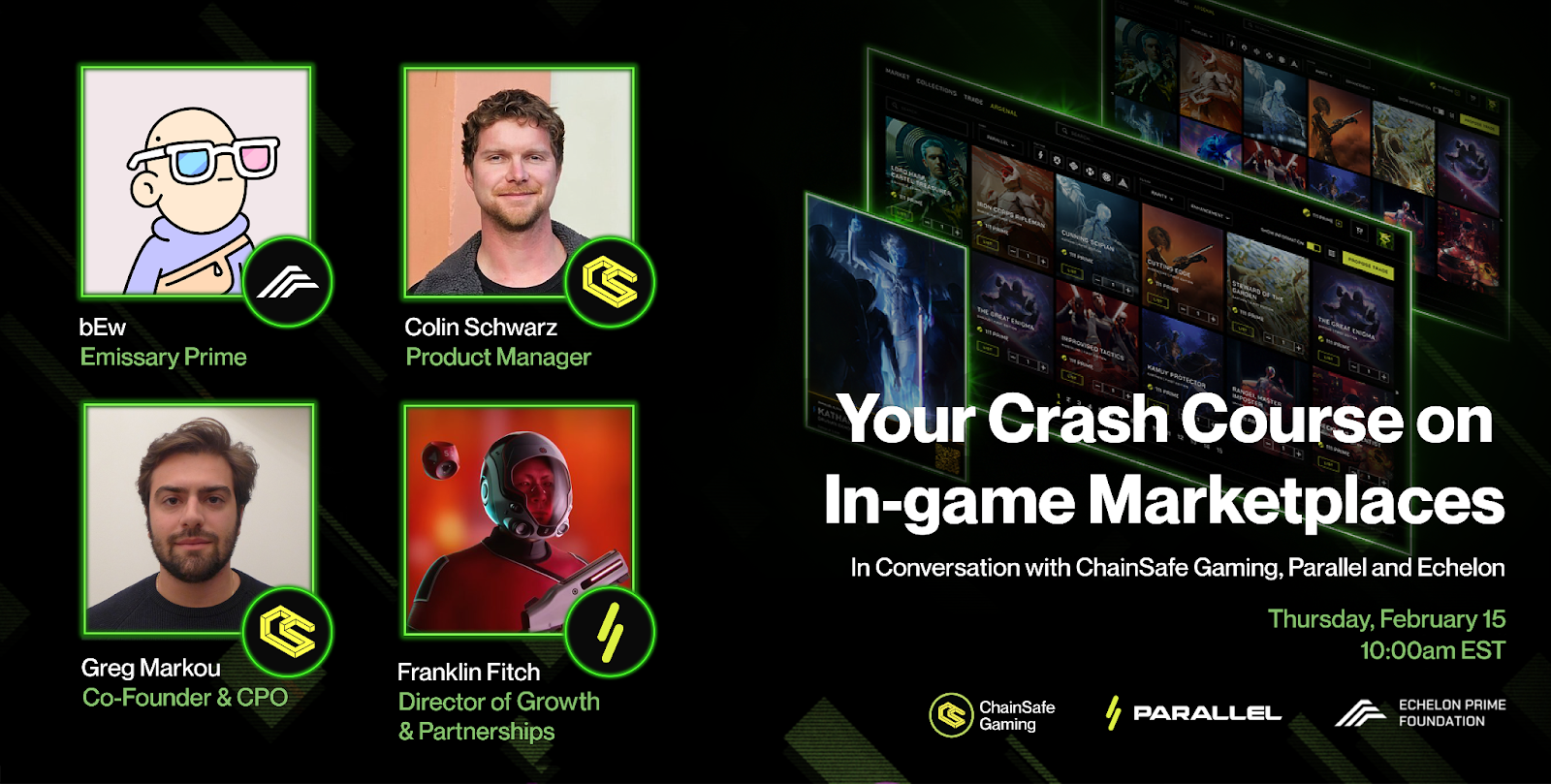Your Crash Course on In-game Marketplaces: With Echelon and Parallel
ChainSafe Gaming, Echelon Prime, and Parallel Studios launched Sanctuary for Parallel in Dec 2023, an integrated marketplace for the web3 trading card game. We sought an open discussion with Echelon and Parallel Studios about the significance of what we're building.

The following is based on a recent Twitter Spaces hosted by Greg Markou (Co-founder & CPO of ChainSafe) and Colin Schwarz (PM at ChainSafe) with guests bEw (Emissary Prime for the Echelon Prime Foundation) and Franklin Fitch (Director of Growth & Partnerships for Parallel)
Last year, ChainSafe Gaming collaborated with the Echelon Prime Foundation and Parallel Studios to produce an integrated, custom marketplace for the web3 trading card game Parallel. The marketplace, dubbed Sanctuary, launched in December 2023. We sought an open discussion with Echelon and Parallel Studios about the significance of what we’re building.
We untangled how game-specific marketplaces, vertical integration, and community building are not only benefitting the player, but setting new standards for our industry’s future.
What’s special about Sanctuary?
Created as a joint effort between ChainSafe Gaming, Parallel Studios, and the Echelon Prime Foundation, Sanctuary is a massive leap forward for digital asset trading in gaming.
Our marketplace offers an immersive, branded experience that feels like a continuation of the game itself, a departure from past NFT marketplaces that often felt like “a site strapped onto the side of a game.”
Sanctuary represents a shift in the web3 conversation toward a more engaging and meaningful interaction between the game and its players, like a bona fide e-commerce experience. With an in-game or branded, game-specific marketplace, game studios can think of their NFT collections as more than a tradable asset. We can ask, “How do we merchandise them?”, “How can we cross-market within them?” and “How can we use the brand identity and customer journey?”
Owning more of the product stack allows studios and developers to condense the user experience and capture more value, boosting conversions and lifting the funnel's top line. Building everything in-house or with the support of a consultant like ChainSafe also frees up resources you can reinvest in user acquisition and game development.
There was another recurring theme in the conversation—community. Engaging players in the marketplace's development process guarantees that it resonates with the user base and serves their unique needs. It fosters a sense of ownership among users, yielding valuable insight that informs the development of new features and functionalities.
“By creating a vertical marketplace, you can learn more about your customers, their needs, and what sort of features are specific to your product.”
Sanctuary stands out by directly integrating features and tools developed within the community, avoiding the competition found in broader marketplaces. This collaborative approach allows the team to enhance the platform with a player-centric and enriched user experience.
Bridging the gap for web3 skeptics
Addressing the skepticism that shadows crypto and NFTs within the gaming community is a pivotal challenge that demands attention.
The conversation between Colin, bEw, Franklin, and Greg emphasized the need for educational initiatives tailored to gamers. By showing examples of the parallelism (get it?) between web3-enabled games and the experiences gamers are used to, we can dispel some of these hard-held misconceptions while introducing the benefits of true digital ownership. Your discovery strategy for a player base should include these gamers—a fun game with good incentives is often enough to pique their interest. After that initial knock, though, we need to get them in the door as smoothly as possible.
Web3 gaming is getting better at simplifying the onboarding process, making it easier for newcomers to get involved in the space. We can abstract away many of the blockchain elements that slow onboarding down with fiat on-ramps, social logins, and gasless transactions, for example. A streamlined, user-friendly introduction to blockchain-enabled games can negate a lot of a player’s initial apprehension, facilitating a smoother transition for gamers exploring this new frontier.
Encouraging this exploration is essential for broadening the understanding and acceptance of blockchain's role in enhancing gaming experiences. Ultimately leading to a richer, more diverse gaming ecosystem that leverages the full potential of contemporary technology.
“There's this misconception amongst the web2 gamer crowd that profiting off of a game or investing in-game assets and playing a game for fun or a game being fun are mutually exclusive things.”
Sharing their experience at a recent Parallel tournament, the Parallel team noticed that the friction between blockchain gaming and your average gamer might not be as pronounced as it seems. When trading card game (TCG) players got their hands on Parallel, they were interested in learning more and collecting the game’s NFT cards. Because Sanctuary feels contained within the game, TCG players trying Parallel get a similar experience compared to the web2 or IRL games they’re coming from.
Beyond web3: Targeting global TCG players
Our discussion also touched on the vast potential of reaching out to the global community of TCG players—many of whom have remained on the fringes of web3.
Traditional TCG experiences, loved for their collectibility, strategy, and community, are conceptually related to blockchain gaming’s offerings. Both, for instance, guarantee true ownership and cater to a rich trading environment. Both worlds have players, people who just like collecting cards, and some savvy speculators looking to profit from the secondary market over time.
By emphasizing these intersections, it's a short jump between the values of TCG players and the higher-fidelity experiences web3 gaming can offer.
Building on this potential, Parallel strategically positions itself as a bridge between the traditional TCG world and web3 by offering TCG enthusiasts a familiar gaming experience. Players can truly own their digital cards, trade them without intermediaries, and participate in a global, secure, and transparent ecosystem.
This gameplay not only preserves the essence of collecting and strategizing that TCG players love but also introduces them to the benefits of digital asset ownership and the broader possibilities within web3.
Parallel's approach exemplifies how leveraging blockchain technology can elevate traditional gaming experiences, making it an enticing proposition for TCG players looking to step into the future of gaming while staying rooted in the aspects they cherish.
“The things that make a TCG a TCG are the collectability, the ownership, the ability to sort out your own assets and the ability to do with them what you want. You can even loan them to a friend. Parallel has that. And it’s the lack of these features on web2 platforms that I see frustrating players all the time.”
Why Blockchain Gaming Matters?
We’re confident in saying that blockchain technology in gaming is on the cusp of reaching a far greater number of players—and its benefits to players and game studios alike will only snowball from there. As we progress, blockchain integrations will continue to unlock unprecedented levels of transparency, security, and ownership, transforming how value is created and exchanged within our game worlds.
For players, this means more control over their in-game assets and a deeper feeling of attachment to their gaming experiences. Studios, on the other hand, stand to gain a more engaged community, reduce fraud within their ecosystem, and create new revenue models that are otherwise unattainable.
The potential for innovation is vast. We’re looking at a future where gaming ecosystems are more connected, economies are player-driven, and the lines between virtual and real-world value blur even further.
So, as blockchain gaming becomes more accessible, don’t be surprised when you hear people asking, “Is this game on a blockchain?”
“Understanding why people in web2 games buy or engage with certain types of digital assets and how web3 or blockchain technology enhances or alters that experience is a better way for the consumer to think about the value proposition of web3. Building a powerful tool that actually supports users helps change the minds of anti-web3 gamers.”


